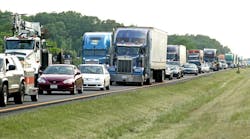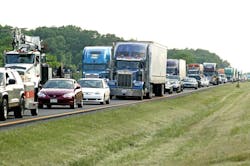Still, Bryan Mistele – CEO of data analytics firm INRIX – believes there’s a strong bond between the two metrics and thinks all the signs are pointing to more traffic gridlock and thus more economic growth ahead for our nation.
"Last year at this time we saw a 19% year-over-year decrease in traffic congestion levels," Mistele recently noted. "Yet we turned a corner in December. Aside from a slight pullback in March, we've seen higher levels of consumer spending and employment lead to dramatically higher levels of gridlock on our roads nationwide."
In particular, the firm’s INRIX Gridlock Index or “IGI” indicated national levels of traffic congestion increased by 8.3% from June 2012 to June 2013 to reach a composite IGI score of 7.2 – meaning the average trip took drivers in the 100 most populated metro areas just over 7% longer due to increased traffic.
Yet Mistele pointed out those congestion figures comes on the heels of higher-than-expected payroll additions but also lower-than-expected consumer confidence readings in June this year, though it also follows sobering news that the U.S. economy is growing slower than expected.
Still, growth is growth, and based on INRIX’s region-by-region analysis of U.S. traffic flows, a series of rebounds seem to be in the offing for various states as well:
- The Northeast displaced the Western U.S. to lay claim to the largest increase in year-over-year traffic congestion (up 12%), noted INRIX. This was driven in part by strong gains in the metro areas of Boston (up 28% year-over-year) and Philadelphia (up 25% year-over-year). It also aligns with recent figures from the U.S. Commerce Department showing that new home sales in the region jumped by 18.5% from May to June.
- The West had the second highest gain in year-over-year traffic congestion (up 9.6% year-over-year), driven in part by two metro areas that have proven most resilient to economic downturns: Los Angeles (up 12% year-over-year) and San Francisco (up 14% year-over-year).
- The Midwest continued to decelerate. Its year-over-year gridlock increases of 14.4% in April and 9.1% in May were followed by a more subdued increase of 4.2% in June. Increases in Milwaukee (up 17% year-over-year) and Minneapolis (up 16% year-over-year) were offset by declines in Toledo (down 28% year-over-year), Columbus (down 19% year-over-year) and Cincinnati (down 4% year-over-year). The Commerce Department also confirmed that new home sales in the region fell by almost 12% from May to June, though some of this weakness may have been caused by regional storms and flooding, the agency stressed.
INRIX’s traffic data also indicated a positive trend developing for now-bankrupt Detroit, with the greater Detroit metro area bucking the Midwestern traffic congestion decline to register a 7% year-over-year increase in gridlock – a development is likely due to the continued resurgence of the area's auto industry as evidenced by Ford Motor Co.'s recent positive earnings report, INRIX said.
Meanwhile, traffic congestion in the South accelerated with its 2.4% year-over-year increase in May followed by an increase of 6% in June, driven by strong gridlock increases in cities like Miami (up 17% year-over-year) and Atlanta (up 10% year-over-year). This is in line with the Federal Reserve Bank of Atlanta's recent report of modest economic expansion in the region, INRIX said.
I must admit, though, that is seems VERY weird to be cheering for traffic gridlock in such fashion – largely because other studies show the costs of such gridlock can be staggering.
Just goes to show that even traffic congestion can have its good and bad points, like anything else.




